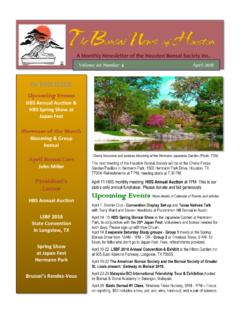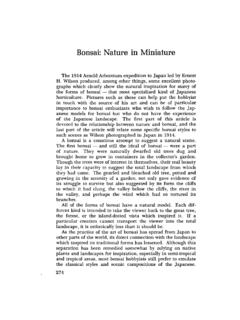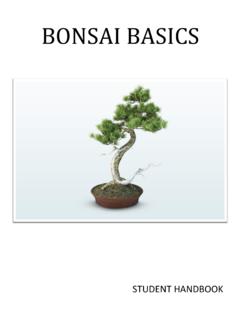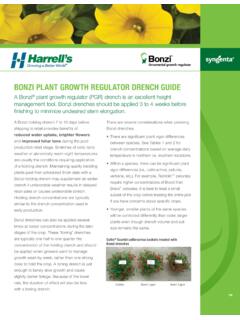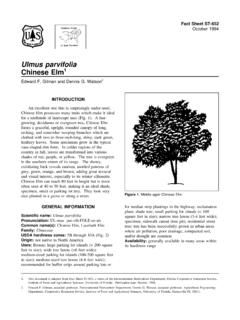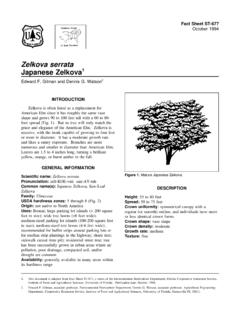Transcription of PINE BONSAI FOLIAGE CONTROL
1 17 INTERNATIONAL BONSAI2005/NO. 2 PINEBONSAIFOLIAGECONTROLF oliage is one of the major elementsused in the design of a BONSAI . Thesize and location of FOLIAGE on thelimbs is of great importance in creating the desired representation. Itis almost always helpful if the bonsaifoliage is small and in scale with thesize of the design. Having foliageappropriately distributed on thebranches, not just at the tips, isimportant for most natural growth characteris-tics of pines make managing the sizeand location of the needle clusters( FOLIAGE ) a bit more challenging thanwith deciduous trees. Managing thefoliage of pine BONSAI is not difficultin itself. The difficulty lies in the factthat it may take two or three yearsfor needle CONTROL techniques to takefull effect. A certain amount of self-discipline and patience is required ofthe BONSAI artist who wishes to main-tain the best possible FOLIAGE on hispine BONSAI .
2 This article will examine needlecontrol techniques for pines commonlyfound in BONSAI collections in thetemperate regions of North America:Scots (Pinus sylvestris),Japanesewhite (Pinus parviflora),Mugho(Pinus mugho),Ponderosa (Pinusponderosa) and Japanese black(Pinus thunbergi). FOLIAGE reduction and locationtechniques for deciduous trees arevery similar for most species. Thefocus tends to be on short periodsduring the growing season with thecertainty that all of the FOLIAGE willdrop in autumn and next year willpresent a clean slate for a fresh are a good bit more interestingbecause the needles persist for twoor three years. This means that aminimum of two or three years arerequired for pines to show the fulleffects of properly applied techniquesfor FOLIAGE location and size. This isnot long in the life of a BONSAI butmay appear to be unpleasantly longfor those of us who are challengedwith impatience.
3 Added interestcomes from the fact that for needlesize reduction, black pine techniquesare quite different from the techniquesused on most other pines. Thus,Japanese black pine needle reductionwill be dealt with in a separate Needle Growth CycleAlthough much has been writtenabout the CONTROL of pine FOLIAGE ,many of us remain confused. Ibelieve that the confusion has less todo with the complexity of the tech-niques than with the lack of cleardefinition of the terms used todescribe the techniques. To help thereader understand the specific definitions as discussed here, I willdescribe the annual growth cycle ofa pine , focusing on the production ofnew needles. Important terms are BudsThe pine budsare arranged in a cluster at the tip of the previousyear s growth. There may be only onebudor as many as seven or eightbudsat the terminal. Each budis anovate shape covered by tiny scalesand slightly pointed on the outer of the budswill normally bemuch larger than the others in thecluster.
4 In most instances, this domi-nant budwill be in the center of thecluster. When temperature and lightconditions are right in the earlyspring, the budsbegin to swell. Aseach budswells, its tiny scalesenlarge, becoming more green color can be seen in thebudwhere none was visible in thedormant season. pine CandlesAs spring warming continues, thebudslose their characteristic shapeand elongate into candles. Candlesare cylindrical growths formed as thescales and central core of the budsgrow longer. At this point, the budceases to exist, having been transformedinto a candle. Candlesmostly grow inlength from the tip. Depending onBy Julian R. AdamsJULIAN ADAMS PHOTOS Scots pine New buds pine New needles pine Pinched candles growing. 18 INTERNATIONAL BONSAI2005/NO. 2the vigor of the plant, a candlemaygrow to more than two feet in lengthin the expansion period which lastsbetween two and three weeks.
5 pine NeedlesAs the candlelengthens, each scaletransforms into a needlecluster, fiveneedlesper cluster for Japanesewhite pines and two needlespercluster for Scots, Japanese black pines,and the others under discussion. Asingle needlecluster can be consid-ered to be a single leaf of a pine . Theneedlesare quite small when theystart to emerge from the scales, giv-ing the candlea prickly a couple of weeks the needlesreach their final mature size. pine ShootsAs the needleslengthen, a point isreached when the candleshape islost and the totality of the newgrowth is called a shootconsists of all of the needleclustersand their supporting stem whichhave emerged from a the needleclusters at thetip of the shootreach their final size,a tiny beginning of budsfor nextyear appears at the tip of the shoot. Coincidentally, the translucent springgreen color of the this point in the annual cycle, theneedleshave hardened off , a termthat means the needlesare matureand will never further increase insize.
6 The remainder of the growingseason is used by the needlesto conduct photosynthesis which provides the energy to fuel the needsof the tree. During the latter portionof the summer the beginning budsincrease in size and number accord-ing to the growing conditions. Normally no further growth takesplace until the cycle is repeated thefollowing year. Needleclusters persist for a minimum of eighteenmonths, sometimes much longer. Atany given time, the newest needlesare closest to the end of a branch. Due to differences in growingconditions, needlesfrom differentyears may exhibit differences in size,color, etc. When the tree has no fur-ther use for old needles,they turnbrown and drop from the tree. Thismostly happens in the fall but happens to a lesser degree at othertimes. Back BuddingBefore needle reduction techniquesare put into effect, there must befoliage at the desired positions onthe limbs.
7 Deciduous plants tend tosprout new growth easily and rapidlyfrom old wood when encouraged bymethods such as severe pruning. Pines are much less inclined tosprout from old wood and they certainly do not do it rapidly or budding or adventitious growthis mostly from needles that have notdropped from the tree or in portionsof wood which have thin bark. Severe pruning, which removesall FOLIAGE from a limb, will normallybring about lush back budding indeciduous trees. The identical opera-tion on a pine (removal of all needles)will result in no budding on thatlimb and the limb will certainly , for pines it is of major importance that limbs and twigs bemaintained with FOLIAGE close to thetrunk. This assures that there will beneedles present to give rise to adventitious buds in addition tothose that appear annually at the endof the current season s shoots.
8 It isvery difficult and takes a long time torestore a pine whose FOLIAGE has allmigrated to the ends of spindlylimbs. When the need arises to createback budding, a combination ofactions will encourage the desiredresult. First and foremost is to givethe tree the maximum possible directsunlight. Pines are sun lovers, sufferinggreatly if not given enough directsun. Bright light isn t enough. Substantial shade is a recipe forsteady decline. Strong sunlight willencourage budding in the center ofolder needle clusters and occasionallyon bare wood. The greatest need isusually to have the adventitious budsappear on bare wood. This is mostlikely to occur on younger twigs butwill happen on older wood occa-sionally. Judicious removal of thickbark on the twig without damagingthe cambium seems to enhance theprobability of bare wood that are wired and bent fordesign reasons seem slightly morelikely to bud on bare wood than normal.
9 Various methods involving theremoval of old needles are used toincrease sun exposure and thusgreater back budding. Certainly oneshould remove all dead needles atthe proper season. The occasionalJapanese black pine Candle black pine Vigorous new candle black pine Cutting shoot to develop short needles. 19 INTERNATIONAL BONSAI2005/NO. 2green needle cluster will remain onthe twig where most have died anddropped off. These persistent needleclusters should not be removed asthey often will develop a new bud intheir center. Wiring and other training workshould be done carefully so as not toremove or damage these points fromwhich new FOLIAGE is likely to growth from adventitious buds(those buds not at the twig terminal)is very fragile for a couple of yearsand should be treated with care untilit achieves some substance. If oneemploys techniques for the removalof green needles, either plucking orcutting, the orientation of adventi-tious buds will likely be more suit-able if needles oriented horizontally(left and right) are saved and verticallyoriented needles (up or down) areremoved.
10 Green needle removaltechniques are usually safe on thevery vigorous Japanese black pinesbut should be used sparingly onmost other , healthy plants are better able to provide the energyneeded for back budding. Heavyfeeding after the needles have hard-ened off helps the tree maintain topstrength while not causing anyincrease in needle length. The budformation season is late summer andearly fall. To give an extra boost inbud making, application of fertilizersintended for the stimulation of rootsand blooms has been quite commercial products of thissort are available at garden are identified by the unusuallyhigh middle number which specifiesthe percentage of available phos-phate. The product I am currentlyusing has an analysis of 10-60-10. Inthe Virginia foothills of the BlueRidge Mountains ( Zone )this formulation is used from the latter part of August until a week ortwo into third key to promoting backbudding is understanding the signifi-cant effect of existing buds on thebranch.
